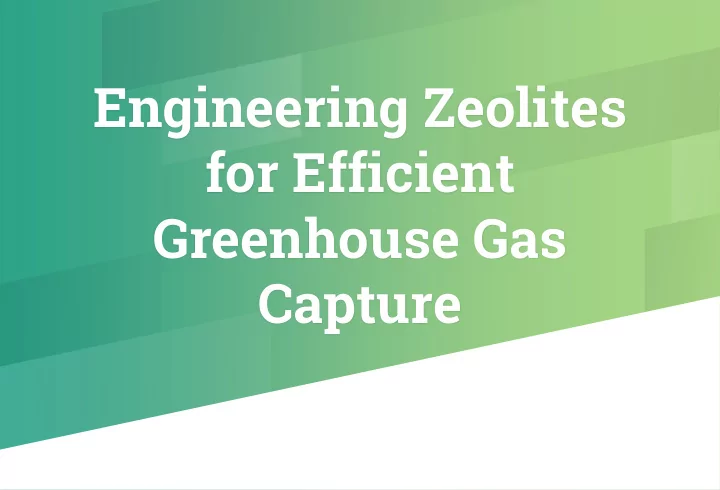

Engineering Zeolites for Efficient Greenhouse Gas Capture
CO ₂ SF ₆ 2
Problem Conventional greenhouse gas capture methods are energy- intensive Figure 1. Amine-based CO ₂ removal process
What are zeolites? ▰ Microporous aluminosilicate minerals ▰ Precisely uniform lattice ▰ Readily modifiable surface properties Framework structure Figure 2. Typical structures of - zeolites Cationic structure - Silica-to-alumina ratio -
To enhance CO ₂ and SF ₆ adsorption capacity by Main introducing mesoporosity into objective zeolites Mesoporous: Microporous: less 2nm~50nm in than 2nm in diameter diameter 5 Figure 3. Representative structures of microporous and mesoporous zeolite
Materials & Methodology Synt nthe hesis is of of zeolite te MF MFI Mesoporous Aluminosilicate Silica MFI aluminosilicate MFI MFI (Si MF MFI) (Al/Si Si MFI) (Me Meso Al/Si Si MF MFI) Silica source: Silica source: Mesopores Tetraethylorth Water glass introduced via osilicate Alumina the soft- (TEOS) source: templating 6 Al ₂ (SO ₄ ) ₃ ᐧ 16H ₂ O method
Materials & Methodology Chara aracte cterisation sation of f zeol olite e MFI 1. Powder X-Ray Diffraction 2. Thermogravimetric Analysis 3. Nitrogen Physisorption Analysis 4. Scanning Electron Microscopy 5. CO ₂ Adsorption Isotherm 6. SF ₆ Adsorption Isotherm 7. N ₂ Adsorption Isotherm 8. Isosteric Heat of Adsorption 7
1. Powder X-Ray Diffraction Confirms the ▰ successful synthesis of zeolites Figure 4. Powder X-Ray diffraction patterns
2. Thermogravimetric Analysis All zeolite MFI ▰ exhibit thermal stability up to 900 ° C Figure 5. Thermogravimetric Analysis
3. Nitrogen Physisorption Analysis ▰ Hysteresis loop shows high degree of pore structure uniformity Figure 6. Nitrogen Physisorption Analysis
3. Nitrogen Physisorption Analysis ▰ Si MFI has the highest surface area and micropore surface area Mesoporosity ▰ increases the Table 1. Textural properties of zeolites surface area and pore volume
4. Scanning Electron Microscopy (b) Al/Si MFI (c) Mesoporous Al/Si (a) Si MFI MFI Figure 7. Scanning Electron Microscopy (SEM) images of zeolites Si MFI Al/Si MFI Meso Al/Si MFI Spherical, nanocrystalline Cubical structure, Rough surface, structure, diameter 100 nm diameter 1 µm diameter 2-3 µm
5. CO ₂ Adsorption Isotherm ▰ Linear adsorption isotherm of Si MFI ▰ Al/Si MFI and meso Al/Si MFI show a type I adsorption isotherm Figure 8. CO ₂ Adsorption Isotherm
6. SF ₆ Adsorption Isotherm ▰ At low pressure, Al/Si MFI has high SF ₆ uptake ▰ At higher pressures Si MFI displays highest adsorption affinity for SF ₆ ▰ For SF 6 adsorption, Pore property is more significant than electric Figure 9. SF ₆ Adsorption field strength in zeolite Isotherm
7. N ₂ Adsorption Isotherm ▰ All zeolites display linear adsorption isotherms ▰ Confirms interaction between quadrupole moment of CO ₂ and adsorption center Figure 10. N ₂ Adsorption in zeolite Isotherm
8. Isosteric Heat of Adsorption (CO ₂) ▰ Indicates the energy penalty for regeneration in CO ₂ ▰ Meso Al/Si MFI has lower energy penalty than Al/Si MFI Figure 11. Qst values for pure- component CO ₂ loading
8. Isosteric Heat of Adsorption (SF ₆) ▰ Indicates the energy penalty for regeneration in SF ₆ ▰ Si MFI has lowest energy penalty despite having strongest affinity for SF ₆ Figure 12. Qst values for pure- component SF ₆ loading
Conclusion ▰ CO ₂ adsorption is enhanced by increased polarity and basicity of zeolite ▰ SF₆ adsorption is dependent on pore property of zeolite ▰ Hence, introducing mesoporosity may not 18 necessarily increase adsorption capacity
Future Work Increase basicity of the zeolite • Grafting of 1 surface of zeolite with functional Cation groups eg. amine exchange to groups, 2 alter window organosilanes aperture of the zeolites
Figure 13. Soft-templating method to synthesize hierarchically-structured zeolite
Brunauer-Emmett-Teller (BET) theory and Langmuir Theory • To calculate the internal surface area of the zeolite • linear plot of adsorption data
Barrett-Joyner-Halenda Theory • measures pore size distribution
Capillary condensation http://coatingsys.com/pdf/What%20is%20capillary%20condensation%20and%20its%20significance%20in%20nanocoatings.p df
Capillary condensation http://coatingsys.com/pdf/What%20is%20capillary%20condensation%20and%20its%20significance%20in%20nanocoatings.p df
Calculation of isosteric heat of adsorption using the virial equation
Ideal Adsorbed Solution Theory (IAST) • predict the adsorption selectivity and the adsorption equilibrium of gas mixtures • from the isotherms of the pure components
References • Chuah, C. Y., Yu, S., Na, K., Bae, T.-H. (2018) Enhanced SF6 recovery by hierarchically structured MFI zeolite. Journal of Industrial and Engineering Chemistry, 62: 64 - 71. • Ciddor, L. A.; Bennett, J. A.; Hunns, J. A.; Wilson, K. and Lee, A. F. (2015) Minireview Catalytic Upgrading of Bio- Oils by Esterification Journal of Chemistry Biotech. • https://www.researchgate.net/figure/Representative- zeolite-frameworks-with-pore-openings-a-zeolite-A-3D- 42-A-b_fig1_225186971 • http://www.separationprocesses.com/Adsorption/AD_C hp01a3.htm
• Zhang, Z., Xian, S., Xia, Q., Wang, H., Li, Z. and Li, J. (2013) Enhancement of CO 2 adsorption and CO 2 /N 2 selectivity on ZIF-8 via Postsynthetic modification. DOI 10.1002/aic.13970
Recommend
More recommend